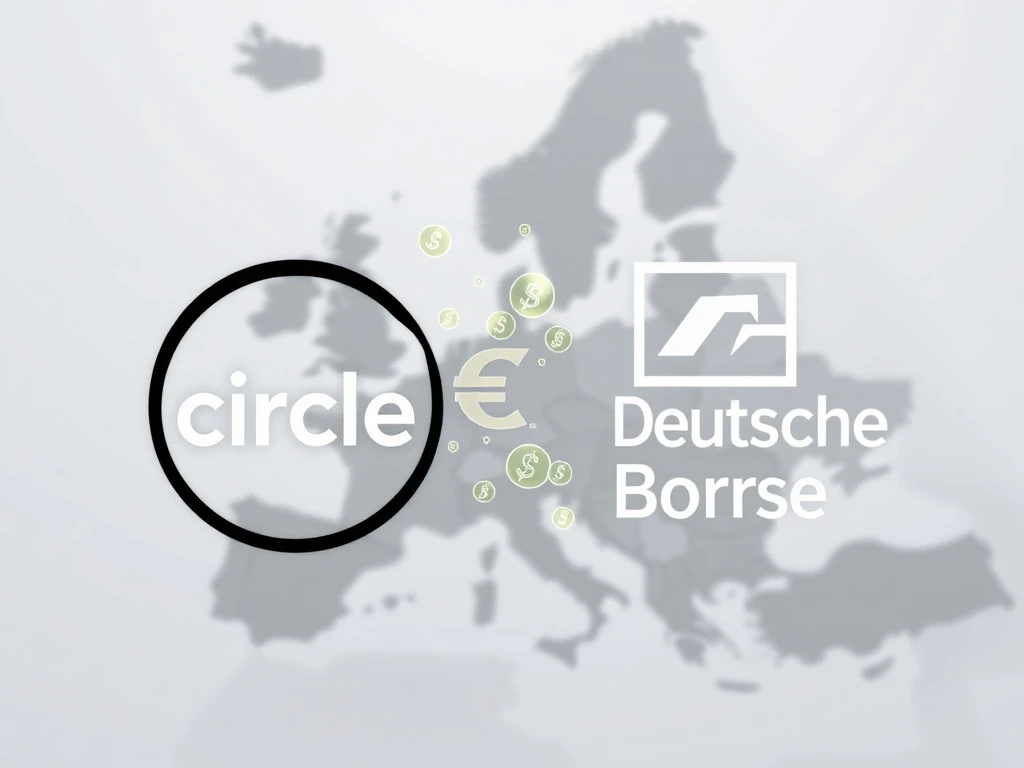Stablecoin Adoption in Europe: Circle and Deutsche Börse Forge a Pivotal Partnership

The cryptocurrency world constantly evolves. Today, a significant partnership promises to reshape digital finance in Europe. Circle, the issuer behind the widely recognized USDC stablecoin, has officially joined forces with Deutsche Börse. This collaboration aims to accelerate stablecoin adoption in Europe, marking a pivotal moment for digital currencies on the continent. Financial institutions and market participants now anticipate enhanced efficiency and reduced settlement risks. This strategic move aligns perfectly with Europe’s developing regulatory landscape.
Circle and Deutsche Börse Drive European Stablecoin Adoption
German securities marketplace Deutsche Börse has formally partnered with Circle Internet Group. This alliance targets increased stablecoin integration across Europe. A memorandum of understanding outlines their shared vision. It seeks to embed Circle’s stablecoins within Deutsche Börse’s extensive financial market infrastructure. Initially, the focus will be on listing and trading. Specifically, this will occur on 360T’s digital exchange, 3DX. Additionally, Crypto Finance, a Deutsche Börse entity, will facilitate these efforts. The partnership prioritizes both Circle’s euro-pegged EURC and its dollar-pegged USDC stablecoins. Consequently, this initiative directly addresses the growing demand for regulated digital assets. The goal is to enhance the accessibility and utility of these digital currencies across the continent.
MiCA Regulation: Paving the Way for Circle Stablecoins
This landmark collaboration is significantly enabled by the European Union’s Markets in Crypto-Assets Regulation (MiCA) framework. MiCA fully entered into force in late 2024. Circle proactively became the first global stablecoin issuer to comply with these comprehensive MiCA rules. Jeremy Allaire, Circle’s co-founder and CEO, confirmed this achievement in July 2024. He emphasized the framework’s importance. Allaire stated, “We’re planning to advance the use of regulated stablecoins across Europe’s market infrastructure.” He further noted this would reduce settlement risk, lower costs, and improve efficiency. This benefits banks, asset managers, and the broader market. Clearly defined rules across Europe are crucial. Aligning regulated stablecoins like EURC and USDC with trusted venues will unlock new products. It will also streamline workflows across trading, settlement, and custody. Furthermore, the partnership extends beyond trading. It aims to enable custody through Clearstream, Deutsche Börse’s post-trade business. Crypto Finance, a German entity, will serve as the sub-custodian, ensuring secure asset management.
Navigating the Evolving European Stablecoin Landscape
The partnership emerges amidst significant regulatory discussions. Reports from Bloomberg indicate European authorities are considering a ban on multi-issuance stablecoins. These are tokens issued in Europe and overseas under a single brand. Sources familiar with the matter suggest the European Systemic Risk Board (ESRB) passed such a recommendation. The ESRB, linked to the European Central Bank (ECB), focuses on macroprudential oversight. This guidance, approved by a high-powered board of central bank governors and EU officials, is not legally binding. However, it certainly adds pressure on authorities to implement restrictions. A senior Bank of Italy official recently argued against multi-issuance. They cited multiple risks to the EU, including legal, operational, and liquidity issues. Therefore, the regulatory environment remains dynamic. Market participants closely watch these developments.
Divergent Strategies: Circle’s MiCA Compliance vs. Tether’s Stance
Circle’s commitment to MiCA compliance stands in contrast to another major player. Tether, the issuer of USDT, explicitly refused to comply with the framework. Tether cited local reserve requirements as its reason. This highlights different approaches within the stablecoin market. Despite these varying stances, local companies actively adopt stablecoins. Some officials acknowledged MiCA’s limited impact on compliant stablecoin adoption in Europe as of May 2025. Nevertheless, progress continues. For example, Société Générale-Forge, the crypto arm of French Société Générale, recently deployed its USD CoinVertible (USDCV) and EUR CoinVertible (EURCV) stablecoins. These are now available on decentralized finance protocols like Morpho and Uniswap. These developments underscore the ongoing evolution of the European stablecoin market. The partnership between USDC Deutsche Börse further solidifies this trend, signaling a clear path forward for regulated digital assets.
The collaboration between Circle and Deutsche Börse marks a significant step forward. It aims to integrate digital currencies deeper into traditional financial systems. This move leverages the clarity provided by MiCA regulation. It also addresses the ongoing regulatory dialogues. The future of Circle stablecoins in Europe looks increasingly integrated and regulated. This partnership could set a new standard for global digital asset adoption, fostering greater trust and efficiency in the financial ecosystem.









